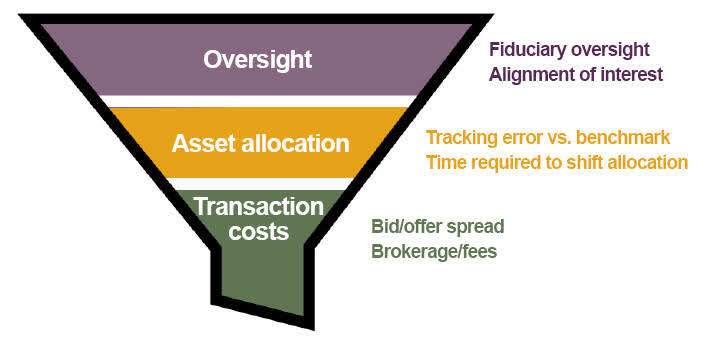DNY59/iStock via Getty Images
It’s no secret that in fixed income markets, excess performance above the benchmark is difficult to achieve over the long run. This is why we believe it’s critical for institutional investors to have a comprehensive transition management approach in place for whenever an investment manager change is needed. Otherwise, alpha is at risk of being squandered, potentially preventing long-term risk and reaching return goals.
So, as a fiduciary, how do you minimize performance slippage during these transition events – and hold on to your hard-earned excess performance? Let’s walk through a common scenario to see what we believe the best strategy for accomplishing this entails.
The scenario
A pension fund would like to terminate an existing U.S. core manager and hire a different manager but understandably does not want to give back years of hard-earned alpha during the transition. The fund’s investment committee is also concerned that the portfolio structure and transaction costs associated with manager changes could erode the excess performance over the benchmark they have accumulated in previous years. The investment staff has been tasked with finding the best solution for making this manager change while preserving alpha.
The challenge
Typically, investment officers, consultants, and other delegated fiduciaries of the board are tasked with identifying the best approach to minimize the performance impact of restructuring the portfolio. Some choose to let the outgoing/incoming asset managers manage components of the restructure without accountability for performance during the change. This effectively leaves performance to chance and hopes that the unmanaged portfolio structure will not cost the pension too much. Simply put, this amounts to a coin flip.
Others take a more proactive approach. They want to understand the critical drivers of performance during this significant change period and want to control and manage them. The key drivers are the same as ongoing investment management mandates. Acknowledging these key drivers allows investors to evaluate different implementation options and choose the best implementation method. We believe there are three primary drivers of performance: oversight, asset allocation, and transaction costs.
Key Drivers Of Benchmark Relative Performance During A Transition
Author
Restructuring options
While there are several options for conducting portfolio restructures, only four transition strategies are most commonly considered. These are:
- Option A – Terminated manager liquidates portfolio to cash
- Option B – New manager restructures to target portfolio
- Option C – Fiduciary transition manager restructures to Treasury basket
- Option D – Fiduciary transition manager restructures to target portfolio
Our full-length research paper has a more detailed explanation of what each of these strategies entails and a timeline depicting a graphical representation of the changes that occur within the portfolio throughout the proposed transition.
We believe only one represents an optimal solution for investors of these four options. Let’s dig in and see why.
Evaluating the options
Option A: Terminated manager liquidates portfolio to cash
This is the easiest option logistically. However, it is the least aligned with the interests of plan participants. This is because a terminated manager is usually not incentivized to maximize performance for the plan but rather to benefit other client accounts (e.g., by trading with the terminated manager’s preferred counterparties).
Option B: New manager restructures to target portfolio
Having the new manager sell the legacy portfolio has a more properly aligned interest. However, the new manager is not accountable for performance in this option until the target portfolio is complete. In addition, the new manager may be less familiar with the nuances of trading the legacy portfolio (most notably, where the legacy portfolio contains illiquid or esoteric assets).
Option C: Fiduciary TM restructures to Treasury basket
While a transition manager will provide performance accountability during the legacy portfolio liquidation, purchasing a duration-neutral basket is not ideal. Although broad market exposure will be maintained (interest-rate sensitivity only), there are transaction costs that the new manager will incur as they sell the treasury basket and purchase their target portfolio.
Option D: Fiduciary TM restructures to target portfolio
Of all the methods discussed, we believe this one allows for the best, risk-managed, and most cost-effective transition of assets into a new allocation. This is because an agency-only transition manager hired as a fiduciary provides transparency into restructuring costs and offers a risk-managed approach to transitioning into a new allocation. Under this approach, an explicit fee is paid to the transition manager for the restructure. An agency-only transition manager will look to reduce spreads via a competitive multi-venue trading approach to achieve the best execution for the client.
The bottom line
Plan fiduciaries must regularly evaluate the best approach for portfolio restructures. We believe the merits of option D clearly highlight the fact that this should be the default for fixed income restructuring. However, we continue to see the other options listed above used, which ultimately subjects investors to significant and uncompensated opportunity costs and sometimes transaction costs. This is unfortunate, as alpha is challenging to achieve – and wasting hard-earned alpha with unmanaged transition costs is unnecessary.
Disclosures
These views are subject to change at any time based upon market or other conditions and are current as of the date at the top of the page. The information, analysis, and opinions expressed herein are for general information only and are not intended to provide specific advice or recommendations for any individual or entity.
This material is not an offer, solicitation or recommendation to purchase any security.
Forecasting represents predictions of market prices and/or volume patterns utilizing varying analytical data. It is not representative of a projection of the stock market, or of any specific investment.
Nothing contained in this material is intended to constitute legal, tax, securities or investment advice, nor an opinion regarding the appropriateness of any investment. The general information contained in this publication should not be acted upon without obtaining specific legal, tax and investment advice from a licensed professional.
Please remember that all investments carry some level of risk, including the potential loss of principal invested. They do not typically grow at an even rate of return and may experience negative growth. As with any type of portfolio structuring, attempting to reduce risk and increase return could, at certain times, unintentionally reduce returns.
The information, analysis and opinions expressed herein are for general information only and are not intended to provide specific advice or recommendations for any individual entity.
Frank Russell Company is the owner of the Russell trademarks contained in this material and all trademark rights related to the Russell trademarks, which the members of the Russell Investments group of companies are permitted to use under license from Frank Russell Company. The members of the Russell Investments group of companies are not affiliated in any manner with Frank Russell Company or any entity operating under the “FTSE RUSSELL” brand.
The Russell logo is a trademark and service mark of Russell Investments.
This material is proprietary and may not be reproduced, transferred, or distributed in any form without prior written permission from Russell Investments. It is delivered on an “as is” basis without warranty.
Editor’s Note: The summary bullets for this article were chosen by Seeking Alpha editors.


Be the first to comment